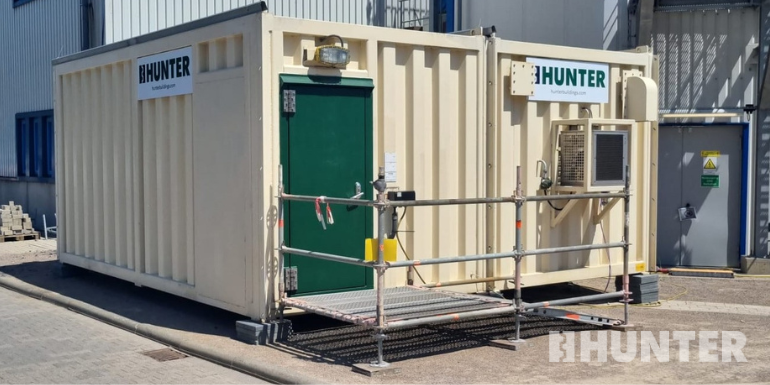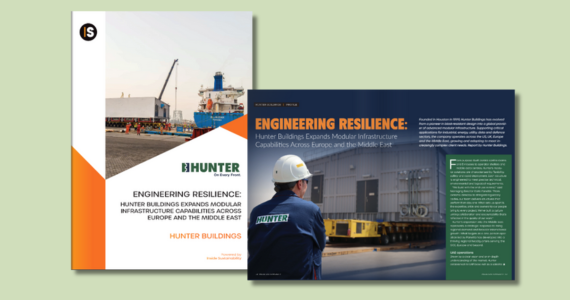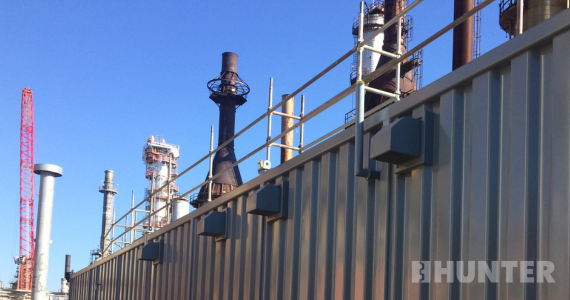In an era marked by escalating security threats, the importance of personal and structural safety cannot be overstated. Entities ranging from governmental organizations to schools and businesses are increasingly investing in protective measures to secure their premises against potential threats. In this article, Hunter’s experts explore the growing demand for ballistic-resistant structures, commonly referred to as “bulletproof buildings.”

Understanding Ballistic-Resistant Structures
A ballistic-resistant structure is meticulously designed to withstand or mitigate damage from firearms and other ballistic impacts. It incorporates highly resistant engineered wall designs, ballistic-resistant doors and, in some instances, multi-layer reinforced glass. Ballistic-resistant buildings undergo extensive testing and evaluation to gauge their protective capabilities. For building construction, North America generally relies on UL 752 standards to evaluate these structures’ protective capabilities against various ballistic threats, ranging from 9 mm bullets to assault rifle ammunition.
The ballistic-resistant structure is common in war zones or conflict areas, and in instances where added security is required to keep items or equipment protected. At Hunter, our forced entry/ballistic-resistant (FE/BR) buildings serve a wide range of uses:
- Protection for Housing, Offices & Controlled Access Areas
- Guard Shacks
- Ammo Bunkers
- Facility Safe Rooms (Shelters)
- Sensitive Compartmented Information Facilities (SCIFs)
- Command Centers
- Storm Shelters
- Data Centers
- Medical Facilities
- Emergency Management Centers
- Ballistic-Resistant Guard Rooms
A Note from Hunter: While colloquially termed “bulletproof buildings,” it’s crucial to note that no structure is entirely bulletproof. A quality ballistic-resistant structure, however, comes remarkably close.
Why Demand for Protective Structures is Rising
Instances of violence, terrorism and civil unrest have increased in many parts of the world. As a result, government agencies, military installations, data/equipment facilities, private businesses, medical facilities, schools and other organizations are seeking ways to enhance facility security. Ballistic-resistant or “bulletproof” buildings offer a critical layer of protection against violent threats.
At the same time, advancements in technology make it more feasible than ever before to build or retrofit existing structures to withstand ballistic threats. New materials and methods, such as modular construction, have decreased the costs of such projects, limited the amount of time workers are needed at the building location site and reduced environmental impact, rendering enhanced safety features more attractive for entities looking to boost security.
Organizations Benefiting from Ballistic-Resistant Buildings
Ballistic-resistant buildings are employed across diverse industries for various purposes:
Government and Military Facilities
Government buildings, embassies and military bases often rely on ballistic-resistant buildings due to the sensitive nature of their operations. These structures are designed to protect personnel, sensitive data and critical infrastructure from hazards including military attacks, espionage and terrorism.
Banks and Financial Institutions
To safeguard high-value assets, banks and institutions such as insurance and investment companies deploy ballistic-resistant construction techniques to secure their facilities. Teller windows, for example, are often protected with reinforced glass, and bank vaults are heavily reinforced to deter and withstand attempted theft.
Data Centers
Data centers rely on ballistic-resistant designs to protect their digital infrastructure and sensitive information in order to ensure reliable and continuous operations.
Law Enforcement Agencies
Police stations and other law enforcement facilities use such buildings as part of their overall security strategy to protect personnel, the public and crucial evidence. Reinforced walls, windows and doors provide invaluable fortification.
Commercial Buildings and Retail Establishments
Businesses that sell expensive items, such as jewelry stores, or those located in high-risk areas, often incorporate ballistic-resistant building elements such as ballistic-resistant doors to create reinforced safe rooms for valuable merchandise and secure cash handling.
Key Features of Ballistic-Resistant Structures
While every building is unique, most ballistic-resistant buildings leverage the following design features to protect personnel and assets.
Protective Wall Design
In ballistic-resistant buildings, traditional walls are often replaced or supplemented with durable materials such as steel or Kevlar, a heat-resistant synthetic fiber. These materials are heavy and expensive. At Hunter, we utilize a steel wall design that is more cost effective and lighter for transport purposes.. Depending on the level of protection needed, walls may be designed with multiple layers, such as an outer impact-resistant layer, a middle layer for absorbing and dispersing energy, and an inner layer for strength and stability.
Reinforced Glass
Much like protective wall designs, bullet-resistant glass is typically comprised of multiple layers of glass and plastic. While the exact composition varies, such glass commonly includes a layer of thermoplastic material sandwiched between sheets of regular glass. This multilayer design helps to absorb and disperse the energy of bullets and blasts, thereby reducing the risk of penetration. Despite its resilience, ballistic-resistant glass is designed to be as transparent as ordinary glass, allowing for both visibility and a high level of protection.
Secure Entrances and Exits
Secure access points are an integral part of “bulletproof” building design. These features may include fortified doors, controls to prevent forced entry and blast-resistant materials that can absorb or deflect the energy from an attempted breach.
The Future of Ballistic-Resistant Buildings
As technology advances, protective structures will continue to evolve. Integrated surveillance systems, automatic locking mechanisms and advanced alarm systems represent developments taking structural design to the next level in terms of safety and security. Progress in material science, including the exploration of nanomaterials, is also likely to produce even more resilient materials, further enhancing the security of ballistic-resistant buildings.
Ballistic-resistant or “bulletproof” modular buildings are much more than just a modern architectural trend. They represent a significant shift in our approach to safety and security, driven by the increasing threats in today’s world. While these structures can’t eliminate global risks, they can provide an enhanced level of protection and peace of mind.
Want to learn more about the possibilities such structures offer — or about Hunter’s custom modular forced entry and ballistic-resistant (FE/BR) security buildings? Contact the Hunter team! Our modular and blast-resistant building experts are eager to help, and we look forward to hearing from you.



